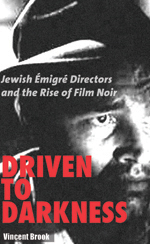(Rutgers University Press, 256 pages, $26.95)
By Vincent Brook
 We've long viewed the film noir genre as the cinematic descendent, the culmination even, of 1920s German Expressionism as formulated at Berlin’s UFA Studios by figures like Fritz Lang, Robert Siodmak, Fred Zinnemann, Billy Wilder and Edgar Ulmer. What has been less discussed—and which Vincent Brook tackles so nimbly and thoroughly in Driven to Darkness—is the role Jewishness played in their movies and sensibility, specifically their Jewishness within the often profoundly anti-Semitic German and Austro-Hungarian empire.
We've long viewed the film noir genre as the cinematic descendent, the culmination even, of 1920s German Expressionism as formulated at Berlin’s UFA Studios by figures like Fritz Lang, Robert Siodmak, Fred Zinnemann, Billy Wilder and Edgar Ulmer. What has been less discussed—and which Vincent Brook tackles so nimbly and thoroughly in Driven to Darkness—is the role Jewishness played in their movies and sensibility, specifically their Jewishness within the often profoundly anti-Semitic German and Austro-Hungarian empire.
On one hand, the Jews of Germany and Austria were the most assimilated, successful, influential and comfortably established of all European Jews. On the other, they were in some ways the least culturally Jewish, or were until the rise of Hitler made it impossible to disavow a religion one had never paid much attention to in the first place. When the axe came down in 1933, their entire world was turned upside-down in an instant, a fate repeatedly reflected in the violent insecurity of characters’ lives in classic noir.
Brook closely traces the various destinies of these filmmakers. Although he may be stretching his thesis to include Lang, who was born to an Austrian father and a Jewish-convert mother and raised Catholic, in this group. Widely regarded as the “the father of film noir,” Lang loomed large at UFA and in Hollywood, and Brook finds thematic and tonal connections to the work of his Jewish contemporaries. But Lang’s subsequent claims about his rediscovered Jewishness after 1933 have been variously disputed as debatable, opportunistic, or mendacious.
The other refugees from UFA fared less well in Hollywood and all lost the relative creative autonomy they’d prized at UFA. Ulmer and Siodmak toiled mainly in B-features (including the cheapest, bleakest, noirest noir of all, Ulmer’s Detour), while Curtis Bernhardt, almost as prominent as Lang at UFA, became a low-profile, noir-tinged director of “women’s pictures” (at least it kept him from having to make Westerns, he later joked). Yet no matter their budgets and success, all of them somehow distilled the horrors of Nazism, forced exile, expropriation and sudden “unpersonhood” into their taut, bleakly fatalistic thrillers and dramas. How they did it, how American they became and how German and/or Jewish they remained are the themes of this book. Illustrated by close readings of dozens of their movies, Driven to Darkness is perhaps the most revelatory and deeply researched study of the genre since James Naremore’s landmark More Than Night: Film Noir in its Contexts.
Review written by John Patterson.